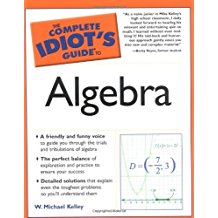Algebra: Multiplying and Dividing Rationally
Multiplying and Dividing Rationally
My nine-month-old son Nicholas has been eating lumpy food for a couple of weeks now; he's not up to solid food yet, and can't actually feed himself, but if you spoon anything mashed into his maw, he will slurp it down. Sometimes, that is. There's always the chance he'll sneeze with no warning, and spray my face and glasses with half-chewed green bean casserole (which is a real treat if I happened to have my mouth open at the time).
He's also good at the spray canlike tongue raspberry, or the less-fancy move in which he just spits whatever's in his mouth right onto his lap. Of course, his digestive system works the same as mine, and once he decides to eat the food in his mouth, the mechanics work the same way they do with mechew, swallow, digest, create foul-smelling diaper. (Actually, the final step there is all his own.)
Basically he and I eat and digest the same way, but when he eats, things are just a lot messier. (I rarely get food in my eyebrows, for instance, especially since I've turned 30.) Similarly, multiplying and dividing with rational expressions works just like multiplying and dividing fractions, only it's sloppier with the larger, variable-heavy expressions.
Remember, you don't need common denominators to calculate a product or a quotient. Multiplying fractions couldn't be easieryou just multiply the numerators together and write the answer over the product of all the denominators:
Don't forget that division is really the same as multiplying by a reciprocal. Just flip the second fraction upside down and make the division symbol into a multiplication sign:
Example 3: Simplify the expressions.
- (a)
- Solution: Rewrite this expression as one fraction, keeping the numerators on top and the denominators on the bottom. However, instead of actually multiplying them together with the distributive property, factor everything.
Kelley's Cautions
Don't forget to check and see if your answer can be simplified, once you're finished multiplying and dividing.
Kelley's Cautions
If all the factors in either the numerator or the denominator are eliminated when simplifying, place a 1 where the factors used to be, like in the final step of Example 3(a). Some students are tempted to put a 0 there instead, because they see nothing left, but that is incorrect.
Simplify the expression by crossing out pairs of matching factors in the numerator and denominator.
Either of those forms of the answer is correct.
- Solution: Start by taking the reciprocal of the right-hand fraction and changing this from a division to a multiplication problem. Notice that the left-hand fraction remains unchanged.
Write the product as a single fraction, factoring every one of those expressions. (You'll have to factor the sum of perfect cubes, so review the formula in Factoring Polynomials if necessary.) To make simplifying easier, I'll rewrite the monomial factor x2 in its factored form, x · x. (One of those x's will cancel out with the x in the denominator.)
Reduce the fraction.
How'd You Do That?
Remember exponential Rule 2 from Encountering Expressions? It said that xaxb = xa - b. Example 3(b) demonstrates why this is true. In that example, I rewrote x2 as x · x, an equivalent repeated multiplication expression, and then canceled out factors to reduce the fraction. Consider the fraction x10x7; according to the rule, that should equal x10 - 7, or x3. If you write out the repeated multiplication, you can see why that's true:
Seven of the x's in the numerator cancel with the seven x's in the denominator, leaving behind x31.
Once again, there's no need to multiply those factors together; a final answer in factored form is just dandy.
You've Got Problems
Problem 3: Simplify the expression x2 - 4x - 123x2 - 10x - 8 · x2 - 3x - 183x + 2.

Excerpted from The Complete Idiot's Guide to Algebra © 2004 by W. Michael Kelley. All rights reserved including the right of reproduction in whole or in part in any form. Used by arrangement with Alpha Books, a member of Penguin Group (USA) Inc.
You can purchase this book at Amazon.com and Barnes & Noble.
